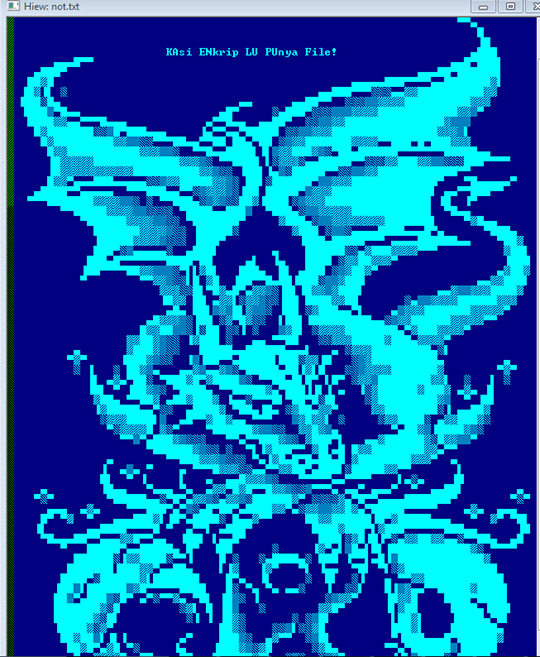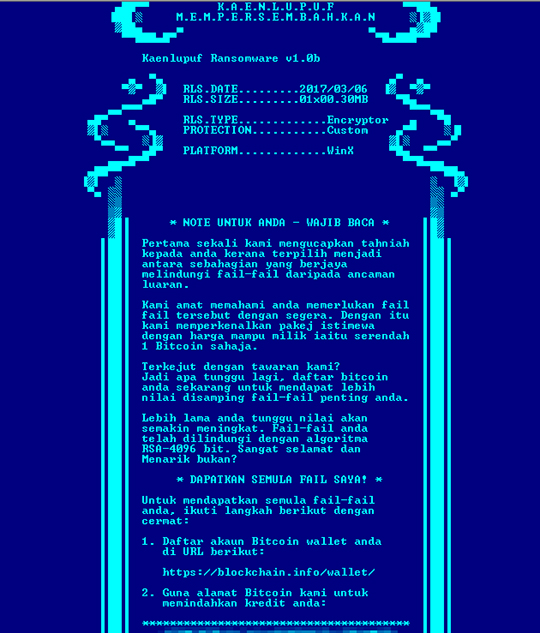RANSOM_KAENLUPUF.A
Win32/Filecoder.NKB (ESET-NOD32), Trojan-Ransom.Kaenlupuf (A) (Emsisoft)
Windows


Threat Type: Trojan
Destructiveness: No
Encrypted: Yes
In the wild: Yes
OVERVIEW
Dropped by other malware, Downloaded from the Internet
This ransomware has an expiration date. It does not proceed with the encryption if it detects a specific date has passed.
To get a one-glance comprehensive view of the behavior of this Trojan, refer to the Threat Diagram shown below.

This Trojan arrives on a system as a file dropped by other malware or as a file downloaded unknowingly by users when visiting malicious sites.
It connects to certain websites to send and receive information.
TECHNICAL DETAILS
461,824 bytes
EXE
Yes
07 Mar 2017
Connects to URLs/IPs, Encrypts files
Arrival Details
This Trojan arrives on a system as a file dropped by other malware or as a file downloaded unknowingly by users when visiting malicious sites.
Installation
This Trojan drops the following copies of itself into the affected system and executes them:
- %ProgramData%\netsvc.exe
- %All Users Profile%\netsvc.exe
(Note: %ProgramData% is the Program Data folder, where it usually is C:\Program Files in Windows 2000, Windows Server 2003, and Windows XP (32- and 64-bit); C:\ProgramData in Windows Vista (32- and 64-bit), Windows 7 (32- and 64-bit), Windows 8 (32- and 64-bit), Windows 8.1 (32- and 64-bit), Windows Server 2008, and Windows Server 2012.. %All Users Profile% is the All Users folder, where it usually is C:\Documents and Settings\All Users on Windows 2000, Windows Server 2003, and Windows XP (32- and 64-bit); C:\ProgramData on Windows Vista (32- and 64-bit), Windows 7 (32- and 64-bit), Windows 8 (32- and 64-bit), Windows 8.1 (32- and 64-bit), Windows Server 2008, and Windows Server 2012.)
It drops the following component file(s):
- %ProgramData%\sejati.iyku ← config
- %System%\ntoskrn1.exe ← copy of normal file mshta.exe
- %User Temp%\services.sys ← HTA Kaenlupuf Notes
- %ProgramData%\public.key ← downloaded key
- %All Users Profile%\public.key ← downloaded key
- %User Temp%\not.txt ← ransom note
- _KAENLUPUF_IMPORTANT_NOTE.log ← ransom note
- %System%\msscandui.dll ← displays ransom note (Windows 10)
(Note: %ProgramData% is the Program Data folder, where it usually is C:\Program Files in Windows 2000, Windows Server 2003, and Windows XP (32- and 64-bit); C:\ProgramData in Windows Vista (32- and 64-bit), Windows 7 (32- and 64-bit), Windows 8 (32- and 64-bit), Windows 8.1 (32- and 64-bit), Windows Server 2008, and Windows Server 2012.. %System% is the Windows system folder, where it usually is C:\Windows\System32 on all Windows operating system versions.. %User Temp% is the user's temporary folder, where it usually is C:\Documents and Settings\{user name}\Local Settings\Temp on Windows 2000, Windows Server 2003, and Windows XP (32- and 64-bit); C:\Users\{user name}\AppData\Local\Temp on Windows Vista (32- and 64-bit), Windows 7 (32- and 64-bit), Windows 8 (32- and 64-bit), Windows 8.1 (32- and 64-bit), Windows Server 2008, and Windows Server 2012.. %All Users Profile% is the All Users folder, where it usually is C:\Documents and Settings\All Users on Windows 2000, Windows Server 2003, and Windows XP (32- and 64-bit); C:\ProgramData on Windows Vista (32- and 64-bit), Windows 7 (32- and 64-bit), Windows 8 (32- and 64-bit), Windows 8.1 (32- and 64-bit), Windows Server 2008, and Windows Server 2012.)
It adds the following mutexes to ensure that only one of its copies runs at any one time:
- WololoWoiyo
Autostart Technique
This Trojan adds the following registry entries to enable its automatic execution at every system startup:
HKEY_LOCAL_MACHINE\SOFTWARE\Microsoft\
Windows\CurrentVersion\Run
Microsoft Service Validator = "%ProgramData%\netsvc.exe"
HKEY_LOCAL_MACHINE\SOFTWARE\Microsoft\
Windows\CurrentVersion\Run
Microsoft Compatibility Check = "%System%\rundll32.exe %System%\msscandui.dll,ServiceMain"
Other System Modifications
This Trojan adds the following registry keys:
HKLM\SOFTWARE\Kaenlupuf
Other Details
This Trojan connects to the following website to send and receive information:
- http://{BLOCKED}uk.xmaya.my
It renames encrypted files using the following names:
- {filename}.kaenlupuf
It does the following:
- It checks the system time and exits if later than March 10, 2017.
- It checks the OS version and exits if the version is Windows 10.
- It avoids encrypting files in the following folders:
- $Recycle.Bin
- AppData
- Application Data
- Boot
- PerfLogs
- Program Files
- Program Files (x86)
- ProgramData
- Recovery
- System Volume Information
- System32
- Windows
- temp
- tmp
- winnt
- It executes the following command lines:
- wmic.exe delete /nointeractive
- vssadmin.exe delete shadows /All /Quiet
NOTES:
This ransom note contains the following message:


It displays the following “Kaenlupuf Notes” window if the following conditions are met:
- System date is not later than March 7, 2017
- OS version is Windows 10
- ‘sejati.iyku’ file exists

SOLUTION
9.850
13.262.04
07 Mar 2017
13.263.00
08 Mar 2017
Step 1
Before doing any scans, Windows XP, Windows Vista, and Windows 7 users must disable System Restore to allow full scanning of their computers.
Step 2
Identify and terminate files detected as RANSOM_KAENLUPUF.A
- Windows Task Manager may not display all running processes. In this case, please use a third-party process viewer, preferably Process Explorer, to terminate the malware/grayware/spyware file. You may download the said tool here.
- If the detected file is displayed in either Windows Task Manager or Process Explorer but you cannot delete it, restart your computer in safe mode. To do this, refer to this link for the complete steps.
- If the detected file is not displayed in either Windows Task Manager or Process Explorer, continue doing the next steps.
Step 3
Delete this registry value
Important: Editing the Windows Registry incorrectly can lead to irreversible system malfunction. Please do this step only if you know how or you can ask assistance from your system administrator. Else, check this Microsoft article first before modifying your computer's registry.
- In HKEY_LOCAL_MACHINE\SOFTWARE\Microsoft\Windows\CurrentVersion\Run
- Microsoft Service Validator = "%ProgramData%\netsvc.exe"
- Microsoft Service Validator = "%ProgramData%\netsvc.exe"
- In HKEY_LOCAL_MACHINE\SOFTWARE\Microsoft\Windows\CurrentVersion\Run
- Microsoft Compatibility Check = "%System%\rundll32.exe %System%\msscandui.dll,ServiceMain"
- Microsoft Compatibility Check = "%System%\rundll32.exe %System%\msscandui.dll,ServiceMain"
Step 4
Delete this registry key
Important: Editing the Windows Registry incorrectly can lead to irreversible system malfunction. Please do this step only if you know how or you can ask assistance from your system administrator. Else, check this Microsoft article first before modifying your computer's registry.
- In HKEY_LOCAL_MACHINE\SOFTWARE
- Kaenlupuf
- Kaenlupuf
Step 5
Search and delete these files
Step 6
Scan your computer with your Trend Micro product to delete files detected as RANSOM_KAENLUPUF.A. If the detected files have already been cleaned, deleted, or quarantined by your Trend Micro product, no further step is required. You may opt to simply delete the quarantined files. Please check this Knowledge Base page for more information.
Step 7
Restore encrypted files from backup.
Did this description help? Tell us how we did.

